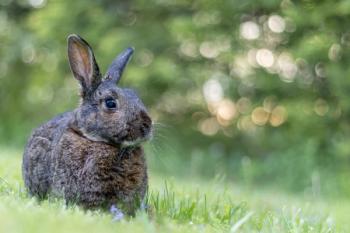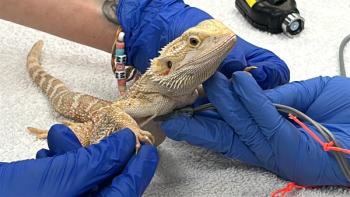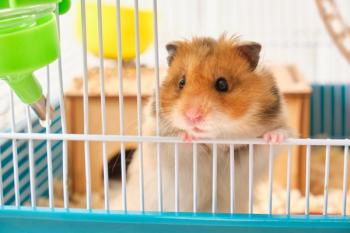
Avian radiology (Proceedings)
Major indications: Radiology is one of the most important diagnostic exam methods in birds. It is extremely well suited due to the poor specificity of disease symptoms a sick bird shows and especially due to the presence of the airsacs in the coelomic cavity. The air in the body and around the organs is a great contrast material.
Major indications: Radiology is one of the most important diagnostic exam methods in birds. It is extremely well suited due to the poor specificity of disease symptoms a sick bird shows and especially due to the presence of the airsacs in the coelomic cavity. The air in the body and around the organs is a great contrast material.
For the patient preparation there are 2 options: Manual restraint vs. chemical restraint. In Different clinicians have different opinions about this issue. The author feels that waterfowl like ducks and geese are sometimes okay for manual restraint, however psittacine patient need to be anesthetized for good quality radiographs as they will try to move and the procedure is very stressful to them. However, if you choose manual restraint, never use hands without gloves to hold on to patient and never expose your body to the primary beam, even when waering gloves!
Many people are tempted to take the image without the gloves as they are very often too bulky to adequately restrain a bird. But please remember that the lead in the gloves does only protect from scatter rays, it is not powerful to block all the x-rays in the primary beam. In addition some special boards are available for manual restraint or they can be self-made. For the commercial product see
Positioning for VD Radiograph
I personally prefer inhalation anesthesia via a facemask and then intubate to maintain the patient with Iso/Sevoflurane. I induce at an initial rate of MAX concenration (to reduce struggling) and then reduce to low percentage (Sevo 2-3%). In severe (life threatening) cases or if the clinical suspicion is strong for specific disease like lead toxicity or egg binding, the bird might be placed on plate without restraint or anesthesia to get an overview of the problem. Of course, these images can't be used to assess normal anatomy and size of organs.
Each radiography unit will have its own settings to be worked out and I recommend to establish a datalog for each machine as there will be slight difference between each unit. As a basic rule one can start to try to use the same techniques for equal sized mammal (e.g. Amazon parrot ~ small guinea pig or chinchilla). For small birds one has to use high details screens (mammography film) in order to get the details of the small organs and bones displayed well. In addition the exposure needs to be < 0.05 sec to avoid motion blur from breathing, which is sometimes difficult with high detail films.
Techniques
A good positioning is VITAL for obtaining diagnostic images. Bad positioning leads to images, which have no diagnostic value. In my opinion, a bad radiograph is worse than not having one at all as you might be able to miss a significant problem due to the poor image quality.
However as mentioned above, there is one exception to the rule and this is to scan for lead or other heavy metal foreign bodies. If the quick scan is the main area of interest, place the bird on the plate and take the radiograph to scan for any metal-like objects.
For the Ventro Dorsal view (VD), the legs are pulled caudally and parallel to the body and fixated with tapes to the plate. The wings are spread in 90° from the body and fixed in this position (sandbags or tape). Make sure that the legs and the 2 wings are spread apart fro each other in order to avoid superimposition fo the humeri and the femurs. In this position the spine and the sternum should be superimposed and appear as one line on the image. The head is gently pulled outwards and fixed with tape. This view is valuable to judge the skeletal system, the abdominal airsacs, the liver and the heart shadow.
The Latero-Lateral position is valuable to judge the skeletal system (esp. head and spine, ribs and sternum), the GI tract, the lungs, airsacs, spleen, kidneys and gonads.
I recommend to use one lateral view as the preferred site for all cases in order to get good references and to be able to compare different images with each other.
Fix the wings and legs with tape and establish a standard for which leg is more cranial (e.g. Place left leg more cranially than right right leg in left lateral position)
In this view the heart shadow should be about 50% of the chest diameter. The liver shadow creates an sand-hour glass appearance with the heart shadow in the normal psittacine patient.
For GI contrast studies we usually use BariumSulfate (20-45%) at 20 -50 ml/kg (higher dose for smaller birds). One can fast the animal for at least 2 hours prior to giving oral contrast, however many others believe that the barium should be given with food to mimic normal peristalsis. Once the contract is given keep the bird in the upright position.
Suction leftover material from crop prior to taking first exposure if anesthesia is being used for the series. The transition times in minutes for different birds have been published in books (e.g. "Diagnostic Imaging of Exotic Pets: Birds, Small Mammals, Reptiles")
The main information gained from GI series are to confirm the position of different coelomic organs, judge the size of coelomic organs, judge the thickness of GI wall and to judge the passage time of GI content. As an alternative one can use fluoroscopy in sick birds, which might be much superior and much SAFER than a traditional contrast study with repeated anesthetic episodes.
Evaluating the respiratory system: The trachea ends at the syrinx in birds. The normal syrinx is difficult to vizualize. The syrinx leads to the primary bronchi, which can't be seen (usually). The lung parenchyma has a honeycombed structure in the normal patient. The brochioles can be vizualized as transverse, linear structures. In male waterfowl the syrinx is visible as the bony structure called the bulla! The airsacs are the radiologists friend. The air sacs give a negative contrast for the coelomic cavity, their size varies between inspiration and expiration. Judge airsacs for their symmetry (if positioning is good), judge them for cloudiness and judge them for inflation.
Evaluating the cardiovascular System: In psittacines the lateral margin of the heart and liver create an hourglass shape. The heart size can vary within a few exposures (cardiac cycle). Especially in older birds, artheriosclerosis with mineralization of the great vessels can be diagnosed. The main arteries can be seen as 'dots' lateral to the heart on the VD view and these 'dots are often confused for pathological lesions.
Evaluating the coelomic cavity: The proventriculus is the continuation from the esophagus. The ventriculus follows and often contains material which makes it easy to locate. The liver is located below the proventriculus. The heart is located cranial to the liver. The kidneys are attached to the ventral side of the pelvis. The small and large GI tract are in the caudal aspect of the coelom. The Gonads and spleen are sometimes visiable. As mentioned before the heart and the liver shadow produce an 'hourglass shadow'. It is difficult to determine which structure is enlarged if this shadow is distorted.
The second view (lat.) is always needed for the evaluation
Enlargement of the spleen, testicles or ovaries and kidneys dislocate the gastointestinal tract ventrally and most often caudally. A displacement of the proventriculus and ventriculus to the dorsal and caudal position can be caused by hepatomegaly
space occupying masses.
Fluid or masses in the coelom results in a homogenous appearance in the coelomic cavity. In these cases it is indicated to perform an ultrasound exam, where the air in the airsacs has been replaced by the contrast medium fluid or other solid masses, this situation is very welcome for an ultrasonic exam in order to achieve a diagnosis. Remember that air is the enemy of the ultrasound!
Evaluating the urogenital system: The best view for investigating the kidneys is the lateral view where the kidneys are surrounded by air, which gives a negative contrast for vizualisation. Dorsally they are attached to the synsacrum and have smoothly rounded cranial and caudal divisions. On the DV view: Bilateral symmetric enlargement of the kidneys can be found in connection with infections, metabolic diseases, and neoplasia.
An increased density can be seen in connection with nephromegaly or with dehydration. Unilateral or localized enlargement can be seen in cases of renal neoplasia, cysts or abscesses. Because of the close location to the kidneys, tumors of the spleen, testicles or ovaries and the oviduct can be misinterpreted for kidney tumors. Often additional imaging is needed in order to identify the origin and structure of the mass effect.
Evaluating the skeletal tissues: The avian skeletal system is a highly specialized structure.
Long bones are air filled and have connection to air sacs (pneumatic bones). The exceptions are young birds where the bones are not fully pneumatized (they are not flying, yet). Physiological variations exist to this normal appearances and it is important to be familiar with the appearance of them. In female birds, which are actively laying eggs, the long bones can be completely solid as these bones are used for calcium storage. Once this phenomenon affects other bones than the femurs and the humeri it can be considered as pathological. Another significant difference in the appearance from mammal radiographs is that osteomyelitis shows most often as a lysis of the affected bone, as pus will not drain. In birds the callus formation after a fracture is often not as marked as in mammals. Very often the external fixator can be removed after 2-3 weeks even if the callus is not strong on the radiographs. If the fixator is left in for longer than 5-6 weeks, osteolytic lesions will usually develop at the site. Other than that osteolytic and osteoplastic changes can be seen in connection with infections or neoplastic processes. Fractures have to be investigated for their location, whether it is simple or comminuted, for articular involvement, the density of the bone, if there is already a periosteal reaction and soft tissue involvement and if the fracture is open or closed.
Conclusion
We a bit of preparation, some knowledge of avian anatomy and physiology the interpretion of avian radiographs are realively straight forward and rewarding.
Newsletter
From exam room tips to practice management insights, get trusted veterinary news delivered straight to your inbox—subscribe to dvm360.






